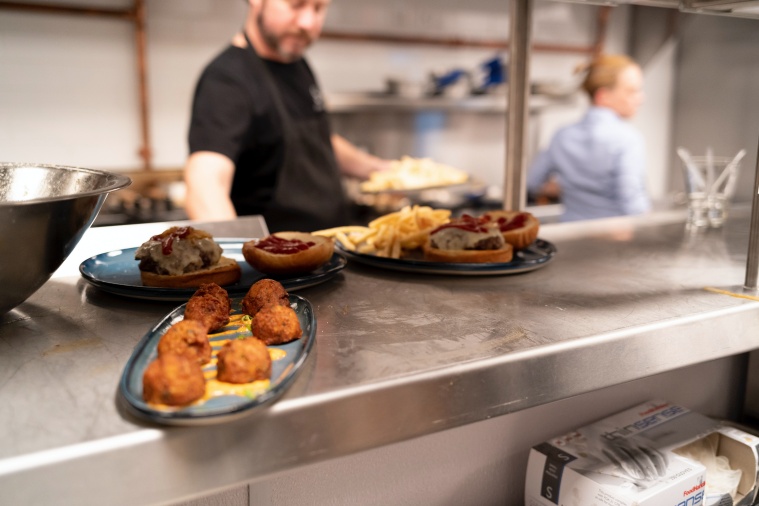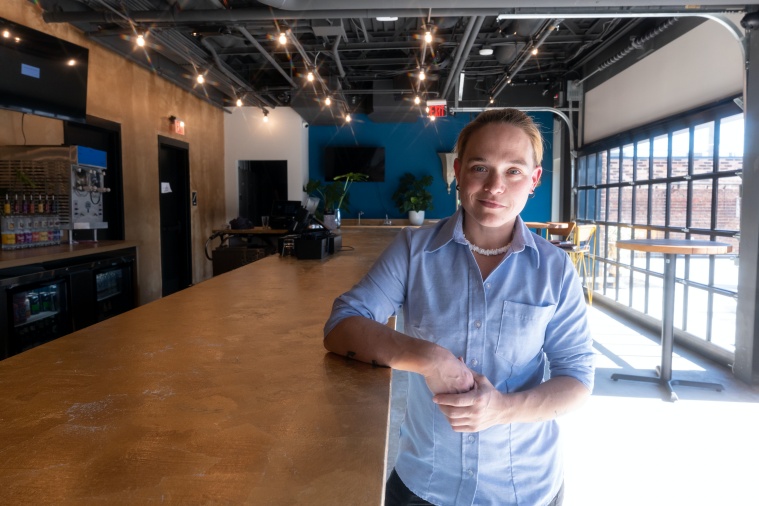If you’re building an entertainment center in sports-crazy Northeast Ohio, it makes sense to go heavy on athletics. That was clear when the Fieldhouse, a 30,000-square-foot complex, opened late last month in this suburb that shares a border with Cleveland.
Thousands of people turned out to scale an outdoor climbing wall, sign up for fitness classes and wander a gymnasium where youth and adult sports leagues will compete.
But there were signs of a detour from the sports playbook: On the first night, the gym hosted a show headlined by the “RuPaul’s Drag Race” stars Monét X Change and Trinity the Tuck.
Subscriber Only Stories
A few hours earlier, about 25 people of all ages gathered at a small community garden a few blocks away to pull radishes and other vegetables from the dirt to help put the garden to sleep before winter. Overseen by Food Strong, a local nonprofit that promotes better nutrition, the garden is where the Fieldhouse’s three restaurants will get some of their vegetables come spring.
 Food prepared during opening weekend at the Fieldhouse, a new LGBTQ entertainment complex in Lakewood, Ohio, a Cleveland suburb. (Daniel Lozada/The New York Times)
Food prepared during opening weekend at the Fieldhouse, a new LGBTQ entertainment complex in Lakewood, Ohio, a Cleveland suburb. (Daniel Lozada/The New York Times)
During a break from raking, Chelsea Brennan, 55, a transgender woman who did electrical installation at the Fieldhouse, said that being able to garden with other LGBTQ people is one reason she plans to move to Lakewood from a small town an hour south.
“Finally I feel like I’m part of a community instead of being an outcast,” she said.
Advertisement
The Fieldhouse is just the first phase of a much larger effort by private developers and local governments to build a complex of businesses and services that cater to LGBTQ people — and attract them to visit or settle here. In effect, they aim to provide the hub for a new gay neighborhood, at a time when many traditional gay enclaves — from Chelsea in Manhattan to the Castro in San Francisco — have lost much of that identity to gentrification and assimilation.
Unlike those intentionally segregated urban neighborhoods, which blossomed in the years after the 1969 Stonewall uprising, this one is based on what its developers think locals need and will support in this solidly working-class city. That means amenities that are affordable and appeal to families, with an emphasis on food.
The entire development, called Studio West 117, is scheduled to be completed in 2025 at an estimated cost of $100 million in private and public funds. Straddling Lakewood and Cleveland, it will include a hotel, shops and health clinic, much of it on the former site of a concert hall where Nine Inch Nails played its first gigs. Studio West’s partners include the Greater Cleveland Food Bank, which will provide fresh vegetables and pantry items for people in need, and the LGBT Community Center of Greater Cleveland, which offers services to seniors and young people.
Advertisement
The developers — Daniel Budish (gay and 36) and Betsy Figgie (straight and 51), both presidents of separate tax-credit consulting firms — are betting that the project will help boost the economy of Cleveland, one of the nation’s poorest large cities.
 Chelsea Huizing, the assistant general manager of the Fieldhouse, a new LGBTQ entertainment complex in Lakewood, Ohio, a Cleveland suburb. (Daniel Lozada/The New York Times)
Chelsea Huizing, the assistant general manager of the Fieldhouse, a new LGBTQ entertainment complex in Lakewood, Ohio, a Cleveland suburb. (Daniel Lozada/The New York Times)
They also want this gay neighborhood, as they call it, to be a home for an LGBTQ community that has long been scattered.
“The best and most significant way to generate resources for our community is with foot traffic that supports small businesses,” said Budish, the son of Armond Budish, the executive of Cuyahoga County, home to Lakewood and Cleveland. “Having seen the way that there are neighborhoods that actively draw gay support, it was important for me, given my skill set, to do large-scale projects that benefit our community.”
He and Figgie say that so far, they have personally invested more than a combined $6 million in Studio West 117. An additional $12 million has come from various sources, including money from the state of Ohio and the federal Small Business Administration, and tax incentives from the City of Lakewood, a community where Pride flags are prevalent.
It’s too early to tell if the area can sustain an entertainment center large enough to birth a neighborhood. The project will have competition for gay dollars from Columbus, where the LGBTQ scene is bigger and, thanks to Ohio State University, younger — a reason many Clevelanders think nothing of driving two hours to see its drag shows or take in one of the country’s biggest Pride parades.
Advertisement
Still, Cleveland’s mayor, Justin Bibb, sounded optimistic that the Fieldhouse could be a real boon for his city.
“A lot of the talk has been about this becoming a first-in-the-nation for queer urban development that’s generating jobs and revenue and prioritizing positive social change and a commitment to social justice,” he said in an interview. “I couldn’t be happier.”
Advertisement
Daniel B. Hess and Alex Bitterman — husbands and the editors of the 2021 book “The Life and Afterlife of Gay Neighborhoods” — said that what’s happening in Cleveland looks markedly different from the places that gay forebears fashioned, not that they would have been disappointed.
“Those people were pioneers, and they were building gay neighborhoods out of absolute necessity to survive and to preserve their own unique subcultural identity,” said Bitterman, a professor of architecture at Alfred State College, in Western New York. “They were doing that with the long-term hope that people wouldn’t have to run away to Manhattan or the Castro to be accepted, that eventually they could live in places like Cleveland and be who they are, where they are.”
Advertisement
Hess, a professor of urban and regional planning at the University at Buffalo, said LGBTQ millennials and Gen Zers are looking to support activities and areas that welcome people regardless of sexual orientation and gender. So it’s no surprise, he said, that plans for a new gay neighborhood would kick off with gardening and other community center-style events, and showcase food.
The three restaurants that were supposed to open last month weren’t quite ready, but that didn’t stop the Fieldhouse from previewing their menus. At an outdoor patio that opened onto a dining room, visitors scarfed down burgers with goat cheese from the area’s Mackenzie Creamery ($13, fries included).
Families shared wood-fired pizzas, including a pepperoni number called the Flirt ($12), from the pizzeria Eat Me! (The other spots are a gastro pub called Muze and a rooftop bar, Trellis.)
On the first Saturday in the Fieldhouse’s intimate demonstration kitchen, Theo Croffoot-Suede, 15, a transgender boy, watched as drag queen Plenty O’Smiles iced cookies. Theo gripped his piping bag and squeezed just so, slowly filling in a pumpkin-shaped cookie with orange icing, careful to stay within a white outline.
An avid home baker of éclairs, Theo said he had traveled from Columbus with his mother, Kim Croffoot-Suede, for the cookie-decorating class because it sounded like “a really good way to intersect baking and being with people who care about me.”
“Being transgender has made me realize how important it is to feel like you have a community,” he said, adding, “I like to go to places where there are people who think I’m a human person.”
Earlier in the day, the group from the community garden made their way to the same kitchen for a salsa-making class taught by Chelsea Huizing, the Fieldhouse’s assistant general manager. Huizing, who is pansexual and goes by Ox, showed students how to safely chop peppers, and explained why chives, but not kale, would be great for salsa.
As the class ended, Joe Makse, 38, who is bisexual, packed a plastic container with his handmade sweet-and-spicy salsa, a blend of peaches, cabbage, tomato, garlic, onions and fresh lemon balm. “I like to broaden my horizons when it comes to cooking,” he said.
Each student got a paper copy of the recipe, which calls for canned corn and tomatoes — the assumption being that not everyone in the class might be able to afford, or even find, fresh vegetables, said Sara Continenza, Food Strong’s executive director, who described herself as “a straight ally.”
It’s not a small consideration: Huizing, 36, said it’s essential that the Fieldhouse attracts blue-collar people, which means there can’t be sticker shock when learning a culinary skill or enjoying a meal.
“Are there some LGBTQ people in Cleveland who can spend 50 bucks a night on dinner? Sure, but not in my circles,” she said. “I want people to think, ‘I can handle my bill.’”
Hess said he was glad that “this world of food and sustainability and community gardens” was happening in the Midwest “rather than Miami or West Hollywood, where it would have gotten lost in the shuffle.”
He added, “It can make a difference in a city like Cleveland.”
This article originally appeared in The New York Times.
For more lifestyle news, follow us on Instagram | Twitter | Facebook and don’t miss out on the latest updates!








